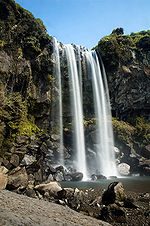- Jeongbang Waterfall
-
Jeongbang Waterfall 
Korean name Hangul 정방폭포 Hanja 正房瀑布 Revised Romanization Jeongbang Waterfall McCune–Reischauer Chŏngbang Waterfall Jeongbang Waterfall is a famous waterfall on Jeju Island.[1] The waterfall is 23 m (75 ft) high and is very close to the ocean.[1][2] Depending on the level of recent rainfall, it can be up 8 m (26 ft) wide.[3] The source of the waterfall is the stream Donghong-chun.[4] According to some sources, Jeongbang Waterfall is the only waterfall in Asia that falls directly in the ocean.[1][2][3][5] However, this may be disputed, since its water falls into a sheltered cove rather than straight into the ocean.[2] Located near Seogwipo, Jeongbang Waterfall is a popular tourist attraction.[6] It is considered Yeongjusipgeong, one of the ten greatest scenic wonders of Jeju.[6]
Legend states that a holy dragon lived underneath it.[7] It was said that the dragon's spirit is contained in the water which can cure diseases and bring rain during drought.[7] Furthermore, a nearby small waterfall is said to resemble a servant waiting on a lord.[7]
A legend states that Emperor Jin of China (259 BC - 210 BC) sent a servant, Seobul, to fetch the magical herbs of eternal youth from Mount Halla.[5][6] Though he failed to find the herb, he encountered Jeongbang Falls on the way and he left his autograph, Seobul Gwaji (which literally means "Seobul was here"[8]), on the cliff wall, where it no longer remains.[6][9] An inscription on the wall of the waterfall saying "Seobulgwacha", refers to Seobul's journey.[5] The waterfall is one of the three famous waterfalls of Jeju, along with Cheonjiyeon Waterfall and Cheonjeyeon Waterfall.[6] A smaller waterfall, Sojeongbang Waterfall is 300 m to the east.[1][5][6]
See also
References
- ^ a b c d Lee, Cecilia Hae-Jin. (2008). Frommer's South Korea. Hoboken, NJ: Wiley. pp. 392. ISBN 978-0-470-18191-1.
- ^ a b c lifeinkorea.com. "Jeongbang Waterfall". http://www.lifeinkorea.com/Travel2/cheju/91. Retrieved 2011-06-06.
- ^ a b Simon Richmond (1 May 2010). Korea. Lonely Planet. p. 297. ISBN 9781741048315. http://books.google.com/books?id=h9-DOFiUI5oC&pg=PA297. Retrieved 7 June 2011.
- ^ Oh, Duck Chul; Choi, Young Chan; Ko, Yong Ku (1992). "An Investigation of the Water Quality of the Streams in Sogwipo City". Korean Journal of Limnology 25 (1): 20–30.
- ^ a b c d "Official Site of Korea Tourism Org.: Jeongbang Falls". http://www.visitkorea.or.kr/enu/SI/SI_EN_3_1_1_1.jsp?cid=264181. Retrieved 7 June 2011.
- ^ a b c d e f "Jeongbang Waterfall in Jeju, Jeongbang Waterfall of Jeju, Korea.". http://www.asiarooms.com/en/travel-guide/south-korea/jeju/sightseeing-in-jeju/jeongbang-waterfall-in-jeju.html. Retrieved 7 June 2011.
- ^ a b c Cecilia Hae-Jin Lee (24 May 2010). Frommer's South Korea. Frommer's. pp. 404–. ISBN 9780470591543. http://books.google.com/books?id=95HEb92jABoC&pg=PA404. Retrieved 7 June 2011.
- ^ "Jeju Weekly". http://www.jejuweekly.com/news/articleView.html?idxno=369. Retrieved 7 June 2011.
- ^ "::Jeju Tour Info::". http://english.tour2jeju.net/main/view.php?idno=50304&menu_id=12. Retrieved 7 June 2011.
External links
Coordinates: 33°14′41″N 126°34′18″E / 33.244649°N 126.571662°ECategories:- Waterfalls of South Korea
Wikimedia Foundation. 2010.
